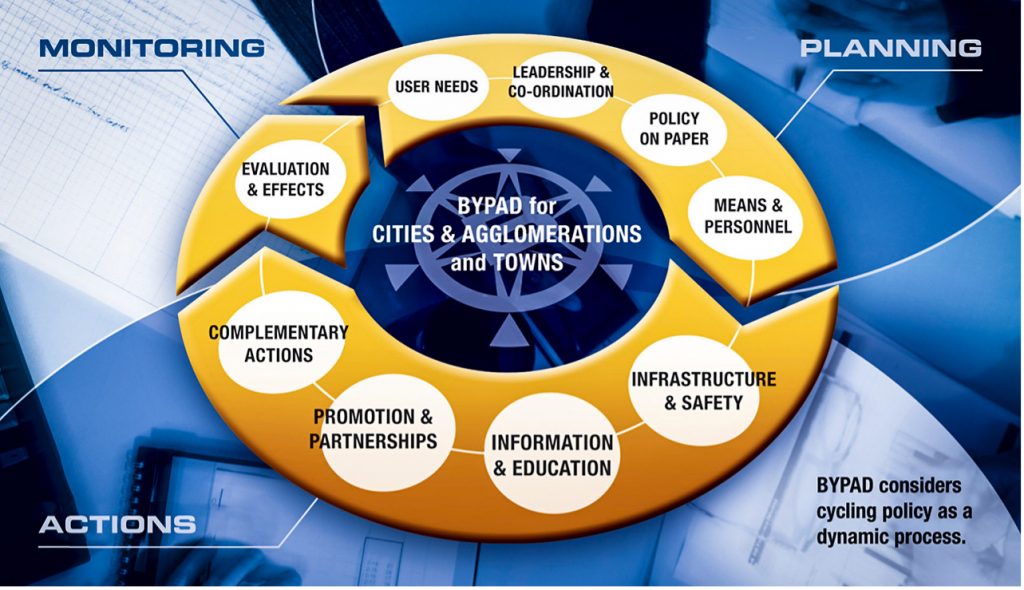Does your city have cycling policies in place? If so, how effective are they really? Created in 1999, the EU-funded BYPAD-project has helped to evaluate cycling policies in almost 250 towns, cities, and regions so far. We summarized key outcomes and found out how it is still relevant 20 years later.
The BYPAD website describes their method of evaluation as a “dynamic process, a whole of 9 fields, in permanent development, influencing each other”. The audits are tailor-made and have been implemented in almost 250 cities and towns in over 25 countries to analyse the current status of the cities’ cycling policy. Let’s take a closer look:
What Exactly Is BYPAD?
BYPAD (Bicycle Policy Audit) is an evaluation tool for cycling policies created by an international group of experts, providing cities with both a diagnosis of their status quo, as well as an action plan with recommendations on how to strengthen the weak parts of their cycling policies. It was developed between 1999 and 2001 and tested in seven European cities: Gent, Graz, Troisdorf, Birmingham, Zwolle, Ferrara, and Grenoble.
Being a great success in the seven test cities, the project was followed by BYPAD+ in 2003 to improve the method and apply it across Europe. Additional regional workshops were held, international seminars were organized and a training programme for auditors was set up.
In 2006, they created a platform to expand the network – and it is still in use today.
How Does BYPAD Work?
The BYPAD tool has a very user-centric approach to make sure everyone’s (politicians, civil servants, user groups, …) opinions and experiences are involved in the process. A core element of the process is an evaluation group consisting of stakeholders from the political, administrative, and private sectors. This wide variety of stakeholders is supported and guided through the BYPAD process by a neutral external supervisor, the auditor.
The auditors are cycling experts that have completed the BYPAD training programme. Before an audit starts, the auditor is given background information about the city that the audit takes place in. Look here to find out if in your country are certified auditors.
To start the BYPAD process, the stakeholders are asked to individually complete a questionnaire that covers all aspects of their cycling policies. Depending on the size of the city (three categories, less than 50.000 inhabitants, over 50.000 inhabitants, and regions), the questionnaire contains different questions.

The questionnaire focuses on nine modules (split into planning, actions, and monitoring modules) that help evaluate the status quo. You can find a detailed explanation of the modules in this document.
The planning modules examine the consideration of bicycle users’ needs, the commitment of politicians, and the funding and quality of policy implementations within the broader policy framework. The action modules are helping you evaluate the cycling infrastructure and its maintenance. The audit looks at how well citizens are informed and educated about cycling policies in their city, taking the encouragement of specific target groups into account as well.
With the audit, you examine how the effects of already existing cycling policies in your city are measured with a special look at safety levels and the numbers of cyclists (monitoring module).
As a result of the BYPAD questionnaire process, the city receives scores for each of the nine modules. Quality levels ranging from one to four reflect your city’s cycling policy. This helps you to find out where improvements are necessary.
Depending on the quality level your city has reached, different approaches will be used in the action plan later:
1. Ad hoc oriented approach:
In this case, your city’s cycling policy is only limited to problem-solving and not embedded into a broader framework. Cycling policy is on a low-quality level due to the lack of funding and unqualified officials. There’s a lot of work to do!
2. Isolated approach:
Better, but still a long road ahead of you! The existing cycling policy is not integrated into the overall transport policy or other policy fields such as land use and health. Because your city doesn’t consider the cyclists’ needs, cycling policies often prove counterproductive.
3. System orientated approach
Even good things can be improved! Cycling in your city is regarded as a system, integrated into the overall mobility policy. Your city’s politicians are willing to support cycling with local strategies and continuous budget allocations. There are different measures implemented for different target groups. Public and private partners are working with politicians. Your policies are based on good data and the user’s need, but many projects have limited running time.
4. Integrated approach:
Your city acknowledges cycling as a permanent task that has strong ties to other policy fields. This is what we’re talking about! You encourage cycle use along with measures to discourage car use. Cycling policies are supported by politicians and regularly funded. The development and implementation of these policies are done by experienced and qualified staff alongside a good outside network. The cycling policies are regularly monitored and evaluated. Keep on doing the good work!
At the end of the BYPAD process, an action plan is developed providing your city with guidance on how you can improve the implementation of your cycling policy.
BYPAD Results in Practice
BYPAD audits were used in almost 250 cities – here are a few examples to show you how BYPAD-recommendations work in practice: During another EU Project, the cities Aalborg, Brighton & Hove and San Sebastián among others implemented the audits with the following results:
Aalborg received an overall audit score of 81% placing them on level 4, integrated approach. In the different modules, Aalborg always achieved level 3 or 4. Because Aalborg already had a cycle path action plan that extended until 2020, the BYPAD process and the later implemented action plan are seen as complementing this plan. As a result of the BYPAD audit, the city took measures such as increased school cycling campaigns, a cycle highway, the creation of a city bike scheme, and commuter travel plans.
For Brighton & Hove, the overall score was a 50.9% which put the cycling policy between level 2 and 3 (isolated approach and system orientated approach). As many modules were not sufficiently covered, the action plan contained actions associated with each one of the modules. The city refreshed its cycling strategy to include the user further. In terms of leadership and coordination, the city appointed a cycle-champion and sought communication with two local universities to increase cycle use.
San Sebastián participated in a BYPAD audit two times, the first being in 2007. In this second audit, their score increased only slightly but overall, the BYPAD process was able to show that by 2010 the number of cyclists had risen to 12,278 cyclists, a 90% increase from 2001. Creating a local bicycle observatory had a significant influence on the number of cyclists; further measures included the extension of the city’s infrastructure and safety. The city added more than 15km of cycle lanes and started bike-rental schemes.
Key Takeaways
There is much to learn from the BYPAD process and these cities about how an evaluation process of cycling policies should look like. Here’s a guideline:
Find the Weakest Link
Evaluation helps you find the strengths and weaknesses of your cycling policy. Only if you find the weakest link you can adjust your policy, which is why BYPAD consists of that many different thematic modules. Make sure your evaluation covers every possible aspect of cycling policy to avoid blind spots.
Involve Various Perspectives
To evaluate and innovate cycling policies, it is important to have a diverse group of people sitting down together and discussing at eye-level. Find out which stakeholders are relevant for the urban city planning of your city (politicians, users, advocates, architects, technicians, …) and get them involved. Only with various perspectives, new cycling policies can be embedded in a broader framework and have positive effects for every citizen in your city.
Having various stakeholders on board from the start will later help you create useful co-operations with local cycling groups as well, who can help you put measures into practice. Those involved should be passionate about the topic and keen to participate – this helps to maximize your audit’s outcome.
Take Realistic Actions That Have Long Term Effects
An evaluation must lead to action. The BYPAD audit results in an action plan that ensures the measures that need to be taken are tailored perfectly to the city’s weaknesses and are achievable. Remember: To get to the point of your dream cycling city, it takes patience and many little steps. Besides, the evaluation has to be an ongoing process – you need to evaluate your cycling policy regularly to make sure you’re heading in the right direction with new actions as well.
How to In a Nutshell…
If you’re aiming to evaluate your city’s cycling policies from a multi-stakeholder perspective, BYPAD is the tool for you. Make sure to evaluate every aspect of cycling you can think of, be it safety levels, user consideration, or education. Repeat the evaluation of your cycling policy regularly to ensure a sustainable improvement in the city’s cycling infrastructure.
For more information on the project head over to the BYPAD homepage and check out the BYPAD folder.


